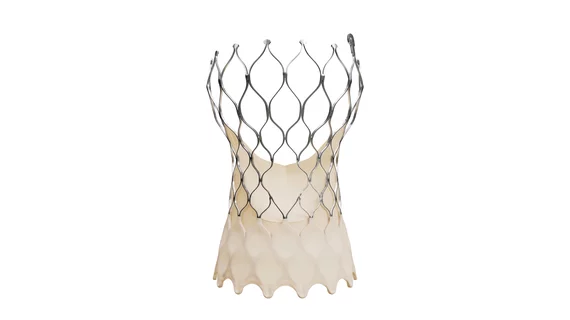Physicians are leaning into supra-annular, self-expanding TAVR valves for women and small-annulus patients
While new cardiac research is published every day, some clinical trials make a more significant impact than others. The SMART (SMall Annuli Randomized To EvolutTM or SAPIENTM*) trial¹, for example, explored differences between patients with a small aortic annulus who were treated with supra-annular, self-expanding EvolutTM valves from Medtronic and those treated with intra-annular, balloon-expandable SAPIEN 3TM valves from Edwards Lifesciences.
Researchers shared one-year results from the SMART trial in 2024, noting both Evolut TM and SAPIEN 3 TM valves had similar safety and clinical outcomes while EvolutTM had superior valve performance compared to the SAPIEN 3 TM. The SMART trial is the largest, most rigorous trial to date, to randomize patients to the two most widely used TAVR devices, and the largest TAVR trial to enroll predominantly women. These findings have impacted heart team discussions and decision-making regarding patient treatment and valve selection considerations.
Anene Ukaigwe, MD†, an interventional cardiologist with University Hospitals Harrington Heart & Vascular Institute in Cleveland, was glad to see the hemodynamic performance validation the one-year SMART data brought.
“It was great to finally randomize the two platforms against each other, especially in this hugely underrepresented patient population,” she says. “We've seen similar primary endpoint outcomes between TAVR and surgical valve replacement from the most current publications of low risk randomized trials from EvolutTM² and SAPIEN 3TM³. SMART confirmed that supra-annular self-expanding valve hemodynamic performanceǂ outperformed intra-balloon-expandable valves in these small annuli patients.”
To Ukaigwe, the data will continue to play a significant role in patient care, especially once a diagnosis of symptomatic severe aortic stenosis has been made and it’s time to discuss treatment options.
“In my opinion, this supports physicians with data we can point to and inform our appropriate patients with small annuli, ‘from what we have learned from SMART, TAVR with a supra-annular, self-expanding valve is going to be the best choice for you, where anatomically feasible, when it comes to hemodynamics,’” she says. “That also helps during our multidisciplinary meetings when we are selecting the valve type we want to use as we await long-term outcomes data from the SMART trial.”
A closer look at valve performance in patients with a small annulus
The SMART trial through 1-year, demonstrated superior bioprosthetic valve performance with supra-annular, self-expanding valves when patients with a small annulus undergo TAVR compared to patients treated with intra-annular balloon-expandable valve. While there are many ways to define valve performance, Ukaigwe notes, the benefits seen with supra-annular, self-expanding valves are present no matter which valve performance variable you focus on.
Bioprosthetic valve dysfunction (BVD), for example, was seen in 9.4% of patients with a self-expanding valve and 41.6% of patients with a balloon-expanding valve at one-year. There was also a significant difference in mean gradient (7.7 mm Hg vs. 15.7 mm Hg) and mean effective orifice area (1.98 cm2 vs. 1.50 cm2) between supra-annular, self-expanding and intra-annular balloon-expanding valves, respectively. While this data only reflects the first year after treatment, Ukaigwe believes the impact of hemodynamic improvements may lead to patients feeling better in the long term.
The SMART trial also showed improvements in quality of life at 12 months in patients who underwent TAVR with supra-annular, self-expanding valves, including a 74.8% improvement in the Kansas City Questionnaire outcomes compared to a 67.8% improvement for patients with an intra-annular, balloon-expandable valves.
“When we replace an aortic valve, our ultimate goal is to treat that patient’s aortic stenosis,” she says. “We do that by opening the valve orifice area to allow laminar flow, thereby reducing gradients in systole, without any significant regurgitation. When we are falling short in those areas, we have not adequately treated the aortic valve stenosis. We made it better, yes, but we did not treat it.”
Another significant data point from SMART was the 30-day moderate or severe patient-prosthesis mismatch (PPM), which was seen in 10.3% of patients with a self-expanding valve and 35.1% of patients with a balloon expandable valve.

“There’s no one size fits all in this business. There never has been, and there never will be. The onus is on us as cardiologists to make sure we offer the very best possible devices for our patients with the available data that we have.”
Anene Ukaigwe, MD, Interventional Cardiologist, University Hospitals Harrington Heart & Vascular Institute
Those numbers are noteworthy because PPM remains one of the chief concerns, in addition to lifetime management considerations, when heart teams treat a small annuli patient.
Surgeons can perform aortic root enlargement during SAVR to mitigate that risk, but that is not an option during transcatheter treatment.
“The only way to mimic the effect of root enlargement and gain effective orifice during TAVR is with the devices we implant,” Ukaigwe says. “So, it was really important to learn which valve designs were associated with a superior valve hemodynamic performance and effective orifice area (EOA).”
As patient data are tracked over time, she adds, cardiologists will be able to learn a great deal about how valve design can directly influence clinical outcomes.
“A lot of the hemodynamic benefits we are seeing with a supra-annular, self-expanding valve come down to the way they were designed,” she explains. “The way the leaflets are attached to the valve frame for each of the valves used in this trial are different. The supra-annular, self-expanding prostheses were designed to optimize EOA compared to the design of the intra-annular, balloon-expandable prostheses used in the SMART trial. We will learn over time if there are clinical benefits related to these design differences and if these hemodynamic data will have a long-term impact on our patients.”
SMART trial made female patients a priority
A huge reason the cardiovascular community has responded so positively to the SMART trial is the above-average percentage of female patients—87%, to be exact—enrolled in the study.
Women with aortic stenosis are less likely to be referred compared to men and are up to 35% less likely to be treated for TAVR or SAVR4. In addition, their mortality risk after developing severe aortic stenosis is higher than it is for men.5 Despite those statistics, however, cardiovascular clinical trials still typically enroll 30 to 40% women⁶, making it more difficult for researchers to identify findings specifically designed to help women as opposed to men. For the SMART trial to include so many women represented a pivotal step forward for cardiovascular care as a whole.
It wasn’t just the high percentage of women that impressed Ukaigwe, however. She says it was important for SMART to include variety of patients with small annuli to ensure its findings were impactful. The SMART trial was not designed specifically for gender, race, or ethnicity, it was developed to focus on annular area of equal to or less than 430 mm2 which, in her practice, is more inclusive of diverse patients who meet criteria.
“It’s great to have so many women in the trial, but the biggest achievement of how SMART was designed to be inclusive of gender, race and ethnicity who all had a small annulus,” she says. “It was primarily women, but you also had male patients who were in the same position from diverse populations”
Momentum keeps building for supra-annular, self-expanding TAVR valves
SMART isn’t the only recent study that points to TAVR with a supra-annular, self-expanding Evolut TM valve as a go-to treatment option for patients presenting with severe aortic stenosis. One analysis presented at New York Valves 2024, for example, the 5-year valve performance was significantly better in patients treated with CoreValve/Evolut TM platform compared to SAVR.7 Additional data published regarding the NOTION-10 trial concluded there was a higher risk of severe structural valve deterioration after SAVR compared to the CoreValve TM platform after a full decade⁸. The list of trials goes on and on, but the end result is the same: supra-annular, self-expanding valves leading to significant valve performance improvements over other treatment options. We will continue to learn more as the 2-year SMART data is expected to be released sometime in 2025.
Ukaigwe highlights how helpful general cardiologists can be to their patients by keeping up with the latest research and guiding them through the entire care process. TAVR is the most common way to replace an aortic valve in the United States in patients aged 65 and older, she says, but it can still be an overwhelming experience for patients. Cardiologists can make a world of difference by knowing the differences and similarities between valve types and understanding both the short- and long-term impact of treatment.
She also emphasizes the fact that every TAVR patient is different. Some may be young, but others may be on the older side. Some may be quite healthy outside of their aortic stenosis, but others may present with a long list of comorbidities. And, yes, some may have a small annulus, but others may not. At the end of the day, cardiologists and their colleagues must work together to do what is best for that specific patient at that specific point in time.
“There’s no one size fits all in this business,” Ukaigwe says. “There never has been, and there never will be. The onus is on us as cardiologists to make sure we offer the very best possible devices for our patients with the available data that we have.”
Click here for indications, safety and warnings. Like any other procedure, TAVR risks can include death, stroke, bleeding.
™* Third-party brands are trademarks of their respective owners. All other brands are trademarks of a Medtronic company.
Click here for additional information.
† Dr. Ukaigwe did not receive compensation for this piece, however, she has received compensation from the medical device industry, including Medtronic.
ǂ Valve performance as defined as freedom from BVD at 12 months. BVD is a composite including any of the following: hemodynamic structural valve dysfunction (mean gradient ≥ 20 mmHg), non-structural valve dysfunction (severe PPM or ≥ moderate aortic regurgitation), thrombosis, endocarditis, and aortic valve reintervention
References:
- Howard C. Herrmann, MD, Roxana Mehran, MD, Daniel J. Blackman, MD, et al. Self-Expanding or Balloon-Expandable TAVR in Patients with a Small Aortic Annulus. NEJM. April 7, 2024.
- Forrest JK, Deeb GM, Yakubov SJ, et al. 4-Year Outcomes of Patients With Aortic Stenosis in the Evolut Low Risk Trial. JACC.October 24, 2023;S0735–1097(23):07628–07633.
- Mack, M. J., et al. (2023). "Transcatheter Aortic-Valve Replacement in Low-Risk Patients at Five Years." N Engl J Med 389(21): 1949-1960.
- Rice CT, Barnett S, O'Connell SP, et al. Impact of gender, ethnicity and social deprivation on access to surgical or transcatheter aortic valve replacement in aortic stenosis: a retrospective database study in England. Open Heart. September 2023;10(2):e002373.
- Tribouilloy C, Bohbot Y, Rusinaru D, Belkhir K, et al. Excess Mortality and Undertreatment of Women With Severe Aortic Stenosis. J Am Heart Assoc. 2021 Jan 5;10(1):e018816.
- Jin, X., Chandramouli, C., Allocco, B., et al. Women’s Participation in Cardiovascular Clinical Trials from 2010-2017. Circulation. 2020;141:540-548. DOI:10.1161/CirculationAHA.119.043594
- Yakubov, S.J., Impact of Bioprosthetic Valve Performance on 5-Year Clinical Outcomes after Self-Expanding TAVI or Surgery in Patients at Intermediate or Greater Surgical Risk. Presentation at New York Valves, 2024.
- Thyregod HGH, Jørgensen TH, Ihlemann N, et al. Transcatheter or surgical aortic valve implantation: 10-year outcomes of the NOTION trial. Eur Heart J. 2024 Apr 1;45(13):1116-1124. doi: 10.1093/eurheartj/ehae043

